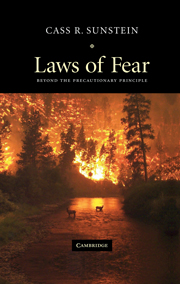3 - Worst-Case Scenarios
Published online by Cambridge University Press: 05 September 2012
Summary
Consider the following problems:
People live in a community near an abandoned hazardous waste site. The community appears to suffer from an unusually high number of deaths and illnesses. Many members of the community fear that the hazardous waste site is responsible for the problem. Government officials attempt to offer reassurance that the likelihood of adverse health effects, as a result of the site, is extremely low. The reassurance is met with skepticism and distrust.
An airplane, carrying people from London to Paris, has recently crashed. Though the source of the problem is unknown, many people suspect terrorism. For the next weeks, many people are taking trains, or staying home, who would otherwise fly. Some of those same people acknowledge that the statistical risk is exceedingly small. Nonetheless, they refuse to fly, in part because they do not want to experience the anxiety that would come from flying.
An administrative agency is deciding whether to require labels to be placed on genetically modified food. According to experts within the agency, genetically modified food, as such, poses insignificant risks to the environment and to human health. But many consumers disagree. Knowledge of genetic modification triggers strong emotions, and the labeling requirement is thought likely to have large effects on consumer choice, notwithstanding expert claims that the danger is trivial.
- Type
- Chapter
- Information
- Laws of FearBeyond the Precautionary Principle, pp. 64 - 88Publisher: Cambridge University PressPrint publication year: 2005



